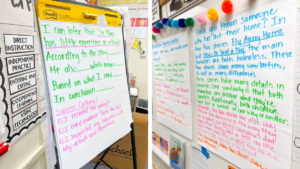Getting students to take a part in their learning is teacher clarity. One way to increase teacher clarity and empower your students to become more independent readers and thinkers is through reciprocal teaching.
What is Reciprocal Teaching?
Reciprocal Teaching was developed in 1986 by Palinscar and Brown. It’s a reading comprehension strategy and involves student-directed groups of four working together with a piece of informational text that’s been separated into small, digestible chunks. Reciprocal Teaching has an effect size of .74. That’s almost two years of growth in one year’s time.
Teachers model, then help students learn to guide group discussions using four strategies: summarizing, question generating, clarifying, and predicting.
Reciprocal teaching is a multi-component approach that combines four strategies into one cohesive structure of increasing comprehension of text: predicting, clarifying, questioning, and summarizing.
This approach helps teachers explicitly scaffold learning to help students become more metacognitive about their reading and learning. Further, it helps students become more active, reflective, and strategic readers.
Why Reciprocal Teaching?
Reciprocal teaching encourages students to think about their own thought processes during reading. It helps students learn to be actively involved and monitor their comprehension as they read. Students are able to ask questions during the reading which helps make the text more comprehensible. Reciprocal teaching also helps students create partnerships with their classmates, which can increase intrinsic motivation as students start to build more friendships as well as an understanding of what they’re reading.
What are the parts of Reciprocal Teaching?
Predicting
Predicting sets the purpose for reading. Before reading, predicting allows students to make an assumption about the text based on the cover, title, illustrations, and prior knowledge.
During reading, students anticipate what will come next by using text structure, content, illustrations, and prior knowledge.
Questioning
Questioning promotes interaction, as students pose questions about the text they are reading to their peers. Engagement in questioning with peers can better equip students to arrive at possible solutions to questions, find relevant information, work cooperatively in groups, and monitor their own comprehension. Students become much more involved in the text and reading when they are posing and answering questions themselves, rather than answering the teacher’s questions.
Clarifying
Clarifying helps students connect to the text as they search a passage for unfamiliar vocabulary words, concepts, or text structures. Within the reciprocal teaching process, students are taught a variety of reading strategies for clarification such as rereading, using decoding skills, and looking within the sentence to extract meaning. Students are also encouraged to use dictionaries and other reference resources to illuminate unknowns within a text.
Summarizing
Summarizing allows readers to recall important details within a text by synthesizing thoughts orally and/or in written form. Recalling important information and concepts within a text can increase metacognition (Stricklin, 2011).
How do I teach Reciprocal Teaching?
Reciprocal Teaching elicits so much thinking for our students. It’s best to introduce each strategy separately to students and to model that specific strategy before having students use all four in an independent group. When students are still learning about Reciprocal Teaching, you might want to assign these as formal roles to your small group of students. This will help them practice each role with different text passages and gain confidence in understanding and using each strategy. Essentially, the goal is to get your students to use these strategies in a fluid way while they’re discussing texts in their groups-they’ll just need some scaffolding to get there.
Informational Text Resources for Using Reciprocal Teaching
Find my Reciprocal Teaching resources here in my shop.





